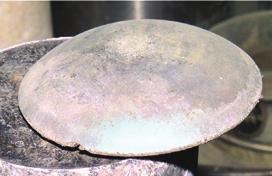Actinide chemistry
Actinide chemistry


Actinide chemistry is the study of the chemical properties of the actinide series, which includes the 15 metallic elements with atomic numbers from 89 to 103, from actinium through lawrencium. These elements are characterized by their radioactive nature and the presence of 5f electrons.
Characteristics of Actinides[edit]
The actinides are known for their high atomic and ionic sizes, and they exhibit a range of oxidation states, typically from +3 to +6. The chemistry of actinides is dominated by the presence of 5f electrons, which are less shielded than the 4f electrons in the lanthanide series, leading to more complex chemistry.
Electronic Configuration[edit]
The general electronic configuration of actinides is [Rn] 5f1-14 6d0-1 7s2. The filling of the 5f orbitals is responsible for the unique properties of these elements.
Oxidation States[edit]
Actinides exhibit a variety of oxidation states, with +3 being the most stable and common. However, higher oxidation states such as +4, +5, and +6 are also observed, particularly in the lighter actinides like uranium, neptunium, and plutonium.
Chemical Properties[edit]
Actinides are typically reactive metals, especially when finely divided. They react with nonmetals at elevated temperatures and form compounds with a variety of elements.
Reactivity[edit]
Actinides react with oxygen, halogens, hydrogen, and other nonmetals. For example, they form oxides, halides, and hydrides. The reactivity of actinides increases with atomic number.
Complex Formation[edit]
Actinides form complexes with a wide range of ligands, including inorganic and organic ligands. The ability to form complexes is due to the availability of 5f, 6d, and 7s orbitals for bonding.
Applications[edit]
Actinides have significant applications in nuclear energy and medicine. Uranium and plutonium are used as fuel in nuclear reactors and in the production of nuclear weapons. Americium is used in smoke detectors, and certain isotopes of actinides are used in cancer treatment.
Environmental and Health Concerns[edit]
Due to their radioactivity, actinides pose environmental and health risks. Proper handling and disposal of actinide-containing materials are crucial to minimize exposure and contamination.
Related pages[edit]
Actinide chemistry[edit]
Ad. Transform your life with W8MD's Budget GLP-1 injections from $75


W8MD offers a medical weight loss program to lose weight in Philadelphia. Our physician-supervised medical weight loss provides:
- Weight loss injections in NYC (generic and brand names):
- Zepbound / Mounjaro, Wegovy / Ozempic, Saxenda
- Most insurances accepted or discounted self-pay rates. We will obtain insurance prior authorizations if needed.
- Generic GLP1 weight loss injections from $75 for the starting dose.
- Also offer prescription weight loss medications including Phentermine, Qsymia, Diethylpropion, Contrave etc.
NYC weight loss doctor appointmentsNYC weight loss doctor appointments
Start your NYC weight loss journey today at our NYC medical weight loss and Philadelphia medical weight loss clinics.
- Call 718-946-5500 to lose weight in NYC or for medical weight loss in Philadelphia 215-676-2334.
- Tags:NYC medical weight loss, Philadelphia lose weight Zepbound NYC, Budget GLP1 weight loss injections, Wegovy Philadelphia, Wegovy NYC, Philadelphia medical weight loss, Brookly weight loss and Wegovy NYC
|
WikiMD's Wellness Encyclopedia |
| Let Food Be Thy Medicine Medicine Thy Food - Hippocrates |
Medical Disclaimer: WikiMD is not a substitute for professional medical advice. The information on WikiMD is provided as an information resource only, may be incorrect, outdated or misleading, and is not to be used or relied on for any diagnostic or treatment purposes. Please consult your health care provider before making any healthcare decisions or for guidance about a specific medical condition. WikiMD expressly disclaims responsibility, and shall have no liability, for any damages, loss, injury, or liability whatsoever suffered as a result of your reliance on the information contained in this site. By visiting this site you agree to the foregoing terms and conditions, which may from time to time be changed or supplemented by WikiMD. If you do not agree to the foregoing terms and conditions, you should not enter or use this site. See full disclaimer.
Credits:Most images are courtesy of Wikimedia commons, and templates, categories Wikipedia, licensed under CC BY SA or similar.
Translate this page: - East Asian
中文,
日本,
한국어,
South Asian
हिन्दी,
தமிழ்,
తెలుగు,
Urdu,
ಕನ್ನಡ,
Southeast Asian
Indonesian,
Vietnamese,
Thai,
မြန်မာဘာသာ,
বাংলা
European
español,
Deutsch,
français,
Greek,
português do Brasil,
polski,
română,
русский,
Nederlands,
norsk,
svenska,
suomi,
Italian
Middle Eastern & African
عربى,
Turkish,
Persian,
Hebrew,
Afrikaans,
isiZulu,
Kiswahili,
Other
Bulgarian,
Hungarian,
Czech,
Swedish,
മലയാളം,
मराठी,
ਪੰਜਾਬੀ,
ગુજરાતી,
Portuguese,
Ukrainian

